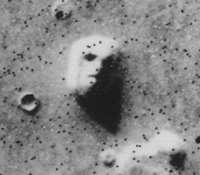
Back إيهام الخيالات المرئية Arabic পাৰেইড'লিয়া Assamese Pareidolia Azerbaijani Pareidolia BCL Парейдолия Bulgarian প্যারেডোলিয়া Bengali/Bangla Pareidolia Catalan Pareidolie Czech Pareidolia Welsh Pareidolia Danish

Pareidolia (/ˌpærɪˈdoʊliə, ˌpɛər-/;[1] also US: /ˌpɛəraɪ-/)[2] is the tendency for perception to impose a meaningful interpretation on a nebulous stimulus, usually visual, so that one detects an object, pattern, or meaning where there is none. Pareidolia is a type of apophenia.
Common examples include perceived images of animals, faces, or objects in cloud formations; seeing faces in inanimate objects; or lunar pareidolia like the Man in the Moon or the Moon rabbit. The concept of pareidolia may extend to include hidden messages in recorded music played in reverse or at higher- or lower-than-normal speeds, and hearing voices (mainly indistinct) or music in random noise, such as that produced by air conditioners or by fans.[3][4] Face pareidolia has also been demonstrated in rhesus macaques.[5]
- ^ "pareidolia". Lexico US English Dictionary. Oxford University Press. Archived from the original on 16 January 2020.
- ^ "pareidolia". Merriam-Webster.com Dictionary. Merriam-Webster. Retrieved 6 December 2020.
- ^ Jaekel, Philip (29 January 2017). "Why we hear voices in random noise". Nautilus. Retrieved 1 April 2017.
- ^ Bauman, Neil (9 July 2015). "Apophenia, Audio Pareidolia and Musical Ear Syndrome".
- ^ Taubert, Jessica; Wardle, Susan G.; Flessert, Molly; Leopold, David A.; Ungerleider, Leslie G. (2017). "Face Pareidolia in the Rhesus Monkey". Current Biology. 27 (16): 2505–2509.e2. Bibcode:2017CBio...27E2505T. doi:10.1016/j.cub.2017.06.075. ISSN 0960-9822. PMC 5584612. PMID 28803877.